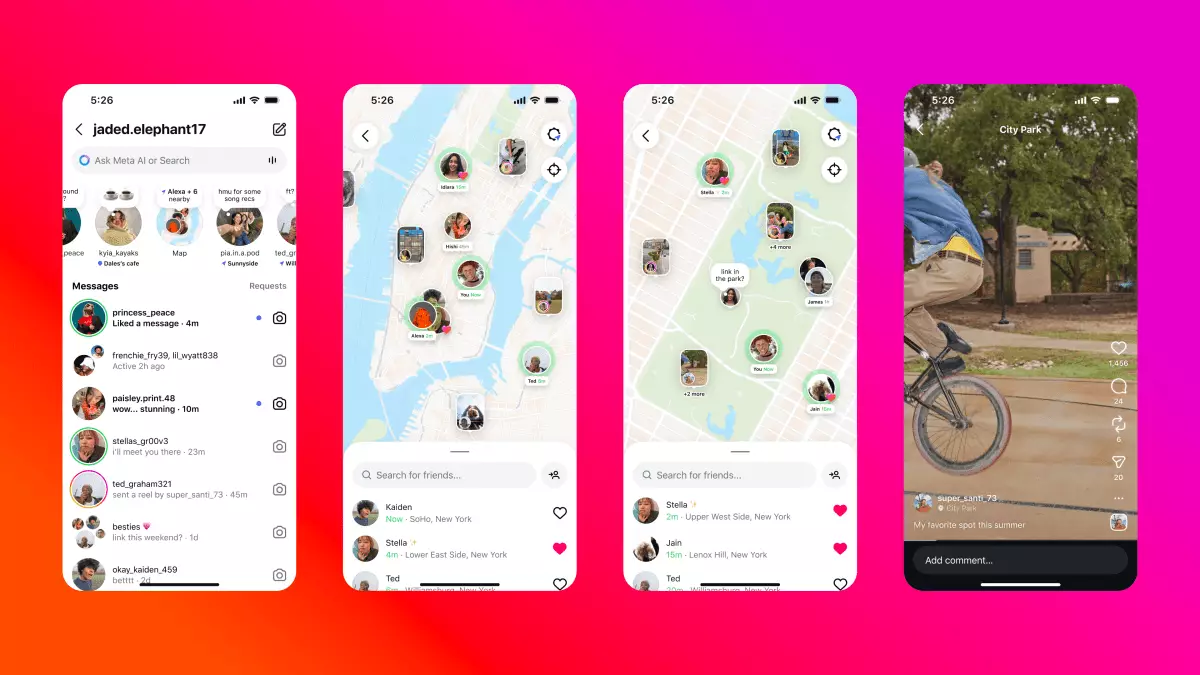In its relentless quest to capture the social landscape, Instagram has unveiled a new location-based feature that undeniably echoes Snapchat’s popular Snap Map. While the platform insists that it is merely innovating, the reality suggests a strategic attempt to outshine competitors by replicating proven successful concepts. Instagram Map, now rolling out in the United States with plans for global expansion, allows users to share their recent locations or explore content tied to specific spots, fostering a sense of connectedness — albeit with notable restrictions and limitations.
What truly sets Instagram Map apart from Snap Map is its opt-in default setting, defaulting to privacy rather than real-time sharing. Users are in control, choosing whether or not to reveal their presence, even temporarily. However, this cautious design choice results in a less immersive experience. Snap Map, by contrast, offers real-time updates, creating a more dynamic, alive map of user activity. Instagram’s decision to limit location sharing to one hour and tying it to app activity — not continuous or real-time feeds — suggests an underlying concern about privacy and user safety. Yet, this cautious approach may hinder the feature’s potential to create spontaneous meetups or truly genuine shared moments.
Despite these limitations, the feature taps into a deep human desire: the need to connect based on shared whereabouts. By visualizing friends’ activities— whether attending festivals or discovering new eateries — the platform deepens social engagement. Moreover, the integration of “Notes” on the map, allowing short, status-like updates, showcases a blend of casual communication and advanced geolocation. Nevertheless, the fact that real-time tracking with indefinite sharing remains exclusive to apps like Snap Map or Apple’s Find My suggests that Instagram’s version is more of a mediated experience, designed to balance engagement with user control.
Reposts and the Power of Content Amplification
Simultaneously, Instagram has enhanced its content-sharing ecosystem by introducing a refined repost feature, aiming squarely at the competitive social sharing space dominated by TikTok and Twitter (X). This addition addresses the need for users to amplify interests and showcase content without creating it from scratch. By enabling reposts of reels and posts, Instagram fosters a cycle of content dissemination that can exponentially increase a creator’s reach and influence, blurring the lines between passive consuming and active participation.
The inclusion of a personalized note feature during reposts adds a nuanced layer of expression, allowing users to contextualize shared content and make their reposts more personal. This subtly shifts Instagram into a more conversational space, where sharing isn’t just about visuals but about storytelling and philosophical alignment with certain trends or ideas. The move resonates with the core purpose of social platforms: community building through content sharing. Still, there’s an underlying risk of clutter and content fatigue. If reposts proliferate unchecked, the feed could become overwhelming, diluting original voices in favor of rehashed material.
The expansion of the “Reposts” tab on profiles further enhances visibility, turning user profiles into curated hubs of shared interests. For creators, this offers a valuable avenue for upliftment and collaborative promotion, potentially shifting the content creation landscape towards more iterative and participatory models. Yet, it also invites scrutiny regarding originality and authenticity—questions that social media giants have long wrestled with. Will this move foster genuine community or create echo chambers filled with recycled content?
Global Reach and Strategic Positioning
As Instagram makes these features available worldwide, its strategy is evident: to position itself as an all-encompassing platform that rivals both Snapchat and TikTok. The apparent homage to Snapchat’s Snap Map highlights a pattern of cross-platform borrowing, but it also signals Instagram’s desire to be the ultimate social ecosystem where sharing, discovering, and engaging happen seamlessly. The availability of the “Friends” Reels tab globally expands the scope of private social interactions, giving users a window into their friends’ interests and engagements without invasive algorithms.
However, this aggressive feature expansion warrants critical reflection. Is Instagram merely adopting trends for the sake of remaining competitive, or does it genuinely understand the evolving needs of its user base? While adding new functionalities can boost user engagement in the short term, it risks fragmenting the user experience, making the platform feel cluttered and over-complicated. The challenge lies in balancing innovation with simplicity—something that Instagram has often struggled with amid its rapid evolution.
Furthermore, by implementing increased control over who can see your activity—such as opting out of the friends’ tab—Instagram shows awareness of privacy concerns, yet it also underscores a paternalistic approach that may alienate users seeking more transparency. As social media evolves into a realm where privacy and sharing intersect, platforms must navigate these treacherous waters carefully; otherwise, they risk alienating their core audience.
In essence, Instagram’s latest features signpost a platform that is consolidating its position in the social media hierarchy by borrowing, refining, and competing fiercely. Whether it can truly deliver meaningful user value amid this swarm of new features remains to be seen. One thing is clear: Instagram is no longer content just as a photo-sharing app but aims to become the central hub for digital social life, whether users want to share locations, repost content, or curate their social universe in multiple dimensions.

